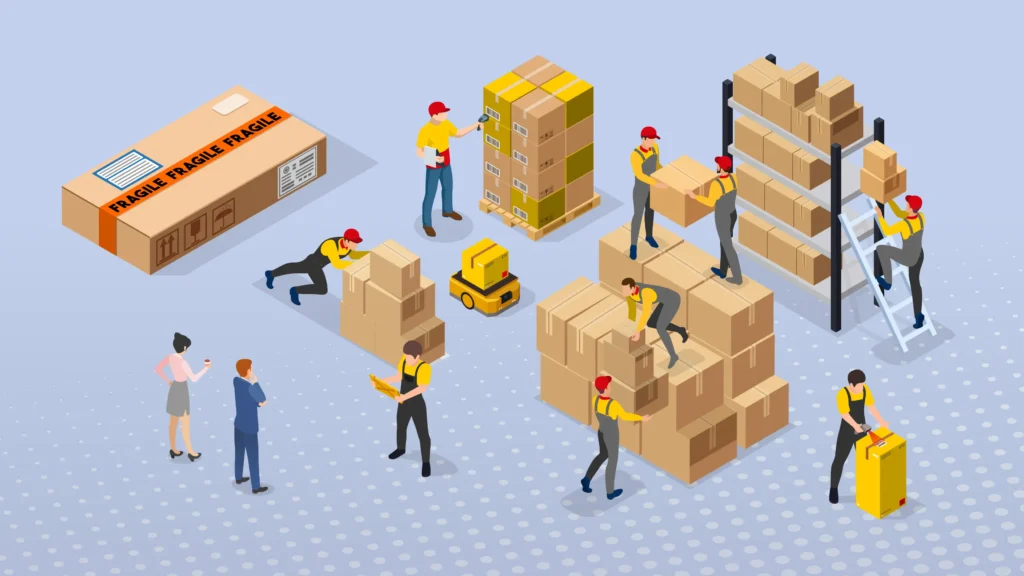The Surge in Demand: What Retailers Face During Peak Seasons
Peak seasons, notably the holiday months, present a double-edged sword for retailers. While they offer opportunities for increased sales, they also bring about significant logistical challenges. Demand surges can be unpredictable, often leading to inventory shortages and overwhelmed supply chains. Retailers must navigate these periods with agility to meet customer expectations and maintain profitability.
Common Challenges: Delays, Capacity Constraints, and Increased Costs
During peak seasons, retailers often grapple with shipping delays due to congested transportation networks. Capacity constraints become a pressing issue as carriers reach their limits, leading to increased shipping costs. These challenges can result in dissatisfied customers and lost sales opportunities.
The Importance of Proactive Planning in High-Demand Periods
Proactive planning is essential to mitigate the risks associated with peak seasons. Retailers should analyze historical sales data to forecast demand accurately, ensuring adequate inventory levels. Establishing strong relationships with multiple carriers can provide flexibility and reduce the impact of capacity constraints. Additionally, investing in technology for real-time tracking and communication can enhance visibility and responsiveness during high-demand periods.
Strategic Planning for Peak Season Success
Forecasting Demand and Inventory Management
Accurate demand forecasting is the cornerstone of effective peak season planning. Retailers should leverage historical sales data, market trends, and predictive analytics to anticipate customer demand. This foresight enables better inventory management, reducing the risk of stockouts or overstocking. Implementing automated inventory management systems can further enhance efficiency and accuracy.
Diversifying Carrier Partnerships for Flexibility
Relying on a single carrier can be risky during peak seasons. Diversifying carrier partnerships ensures greater flexibility and resilience in the face of capacity constraints or service disruptions. By collaborating with multiple carriers, retailers can optimize shipping routes, negotiate better rates, and maintain consistent delivery performance.
Implementing Technology for Real-Time Tracking and Communication
Technology plays a pivotal role in modern logistics. Real-time tracking systems provide visibility into the movement of goods, enabling retailers to proactively address delays or issues. Advanced communication tools facilitate seamless coordination between retailers, carriers, and customers, enhancing the overall shipping experience. By integrating comprehensive shipping solutions for retailers, businesses can streamline operations and improve customer satisfaction.
Optimizing Shipping Methods for Cost and Efficiency
Evaluating Full Truckload (FTL) vs. Less Than Truckload (LTL) Options
Choosing the appropriate shipping method is crucial for cost-effectiveness and efficiency. FTL shipping is ideal for large shipments that can fill an entire truck, offering faster transit times and reduced handling. Conversely, LTL shipping is suitable for smaller shipments, allowing multiple retailers to share truck space and costs. Evaluating the size, weight, and urgency of shipments helps determine the most appropriate method.
Benefits of LTL Shipping for Mid-Sized Retailers
LTL shipping offers several advantages for mid-sized retailers. It provides cost savings by sharing transportation expenses with other shippers, making it a budget-friendly option for smaller shipments. Additionally, LTL shipping offers flexibility in scheduling and routing, accommodating varying shipment sizes and frequencies. To maximize these benefits, retailers should consider LTL carrier selection tips to choose reliable and efficient carriers.
Consolidation Strategies to Maximize Load Efficiency
Consolidating shipments can significantly enhance load efficiency and reduce shipping costs. By combining multiple smaller shipments into a single load, retailers can optimize truck space utilization and minimize transportation expenses. Implementing consolidation strategies requires coordination with suppliers and carriers to align shipment schedules and destinations effectively.
Enhancing Customer Experience Through Reliable Shipping
Importance of Transparent Communication with Customers
Transparent communication is vital in managing customer expectations during peak seasons. Providing timely updates on order status, potential delays, and delivery timelines fosters trust and reduces customer anxiety. Utilizing automated notification systems and customer service platforms ensures consistent and effective communication.
Offering Multiple Delivery Options to Meet Customer Expectations
Offering a range of delivery options caters to diverse customer preferences and needs. Expedited shipping, standard delivery, and in-store pickup options provide flexibility and convenience. By accommodating various delivery preferences, retailers can enhance customer satisfaction and loyalty.
Handling Returns Efficiently During Peak Times
Efficient return processes are essential to maintain customer trust and satisfaction. Implementing streamlined return policies, providing clear instructions, and offering convenient return options can mitigate the impact of returns during peak seasons. Leveraging technology to automate return authorization and tracking further enhances efficiency.
Case Studies: Successful Peak Season Shipping Strategies
Retailer A: Leveraging Technology for Inventory Management
Retailer A implemented advanced inventory management systems to enhance visibility and control over stock levels. By integrating real-time data analytics and automated replenishment processes, they reduced stockouts and overstock situations. This technological adoption resulted in improved order fulfillment rates and customer satisfaction during peak seasons.
Retailer B: Building Strong Carrier Relationships
Retailer B focused on establishing strong relationships with multiple carriers to ensure flexibility and reliability. By diversifying their carrier network and negotiating favorable terms, they mitigated the risks associated with capacity constraints and service disruptions. Implementing effective peak season shipping strategies led to improved delivery times and customer satisfaction.
Retailer C: Streamlining Returns Process to Maintain Customer Loyalty
Retailer C revamped their returns process to enhance efficiency and customer experience. They introduced user-friendly return portals, automated authorization systems, and multiple return options. These improvements reduced processing times and increased customer satisfaction, fostering loyalty even during the high-pressure peak season.
Preparing for the Unexpected: Risk Management in Peak Seasons
Developing Contingency Plans for Supply Chain Disruptions
Supply chain disruptions can occur unexpectedly during peak seasons. Developing contingency plans, such as alternative sourcing strategies and backup transportation options, ensures business continuity. Regularly reviewing and updating these plans enhances resilience against unforeseen challenges.
Insurance and Liability Considerations
Adequate insurance coverage is crucial to protect against potential losses during peak seasons. Retailers should assess their insurance policies to ensure they cover risks such as shipment delays, damages, and losses. Understanding liability clauses in carrier contracts also helps in managing financial risks effectively.
Training Staff for Peak Season Challenges
Well-trained staff are essential to navigate the complexities of peak seasons. Providing training on handling increased workloads, managing customer inquiries, and utilizing new technologies enhances operational efficiency. Investing in employee development fosters a capable and adaptable workforce.
Looking Ahead: Future Trends in Peak Season Logistics
The Role of AI and Automation in Shipping
Artificial intelligence (AI) and automation are revolutionizing logistics by enhancing efficiency and accuracy. AI-powered systems can predict demand patterns, optimize routing, and automate warehouse operations. Embracing these technologies enables retailers to respond swiftly to peak season demands and improve overall performance.
Sustainable Practices in Retail Logistics
Sustainability is becoming increasingly important in logistics. Implementing eco-friendly practices, such as using electric delivery vehicles and optimizing packaging, reduces environmental impact. Sustainable logistics not only benefits the planet but also appeals to environmentally conscious consumers.
Evolving Customer Expectations and Delivery Standards
Customer expectations are continually evolving, with a growing demand for faster and more flexible delivery options. Retailers must adapt by offering same-day delivery, real-time tracking, and personalized delivery experiences. Staying attuned to customer preferences ensures competitiveness in the dynamic retail landscape.
Actionable Steps for Retailers: Implementing Effective Shipping Strategies
Assessing Current Shipping Practices
Retailers should conduct comprehensive assessments of their current shipping operations to identify areas for improvement. Analyzing metrics such as delivery times, shipping costs, and customer feedback provides insights into performance gaps.
Setting Measurable Goals for Improvement
Establishing clear, measurable goals facilitates targeted improvements in shipping strategies. Objectives may include reducing delivery times, lowering shipping costs, or enhancing customer satisfaction. Regularly tracking progress against these goals ensures accountability and continuous improvement.
Continuous Monitoring and Adjustment of Strategies
The dynamic nature of retail logistics necessitates ongoing monitoring and adaptation of shipping strategies. Retailers should remain agile, ready to adjust plans in response to market changes, customer feedback, and operational challenges. Embracing a culture of continuous improvement fosters long-term success.
Building Resilience: Long-Term Logistics Planning Beyond Peak Seasons
Investing in Scalable Infrastructure
Scalable infrastructure enables retailers to adapt to fluctuating demand levels. Investments in modular warehouse systems, flexible transportation options, and advanced technology platforms support growth and resilience.
Establishing Year-Round Carrier Relationships
Maintaining strong relationships with carriers throughout the year ensures better service during peak seasons. Consistent collaboration with logistics partners fosters trust, facilitates better negotiation, and enhances service reliability. Rather than only reaching out during busy periods, year-round engagement allows for better preparedness and responsiveness when demand spikes.
Continuous Staff Training and Development
Building a resilient logistics operation requires ongoing investment in personnel. Regular training equips staff with the skills needed to handle peak workloads, operate new technologies, and adapt to changing procedures. Development programs that foster leadership and cross-functional capabilities also contribute to a more agile and capable workforce. A company culture that values learning ensures readiness for any seasonal or unexpected challenges.
Navigating Peak Season Shipping with Confidence
Peak season shipping doesn’t have to be a logistical nightmare. With the right strategies—rooted in data-driven forecasting, strategic partnerships, technological integration, and proactive planning—retailers can transform challenges into opportunities. From leveraging flexible shipping methods and improving customer communications to preparing for disruptions and embracing future trends, every effort contributes to a seamless shipping experience. Retailers who invest in these areas not only survive the busiest times of the year but also strengthen their long-term logistics capabilities. The key is continuous improvement, resilience, and a customer-first mindset that drives both operational excellence and brand loyalty.






